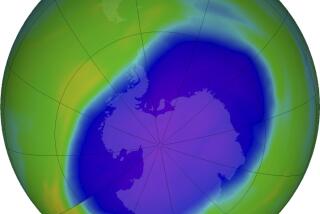Developments in Brief : New Theory Offered for Hole in Ozone
- Share via
A newly discovered shower of high-energy particles appears to bombard Earth’s atmosphere every 27 days and may be responsible for the puzzling hole in the ozone layer over Antarctica, scientists say.
The discovery, made with new satellite data compiled by researchers at the Los Alamos National Laboratory in New Mexico, suggests that the particle shower lasts an average of 2 1/2 days, dumping 1 billion watts of energy per second into Earth’s middle atmosphere.
The ozone layer, about 15 miles above Earth, screens out more than 99% of the sun’s ultraviolet radiation. A widening hole in the layer has been observed over Antarctica.
Scientists have been concerned since the 1970s about an apparent thinning of the layer, and many have blamed the damage on chemical pollutants called chlorofluorocarbons.
The electron showers were detected by an instrument aboard a satellite. The electrons tend to spiral down the planet’s magnetic field lines, moving toward the North and South poles.
The discovery of the electron showers was announced last week at a meeting of the American Geophysical Union in Baltimore. Researchers at the National Aeronautics and Space Administration collaborated on the study.
Dan Baker, of the Earth and Space Sciences Division at the New Mexico laboratory, said the high-energy electrons can mix with atmospheric gases to produce nitrogen and hydrogen compounds that can reduce ozone. He said stable air circulation over Antarctica might help concentrate the compounds produced by electron showers, creating the hole in the ozone. The North Pole has a more uniform magnetic field and unstable air pattern, which would make ozone depletion less likely, Baker said.
He said the study of electron showers also could shed light on how chlorofluorocarbons affect the ozone layer. “We are not really sure which of these two models is correct,” Baker said, referring to the effect of electron showers and chlorofluorocarbons on the ozone layer. “This appears to be a very complex issue and there is not one clean, simple answer.”
Scientists have said that destruction of part of the ozone layer could cause crop failure, climatic changes and a rise in the number of human cases of skin cancer. Chlorofluorocarbons are used as coolants in refrigerators and air conditioners, as propellants in aerosol sprays and as solvents in the production of computer chips.




